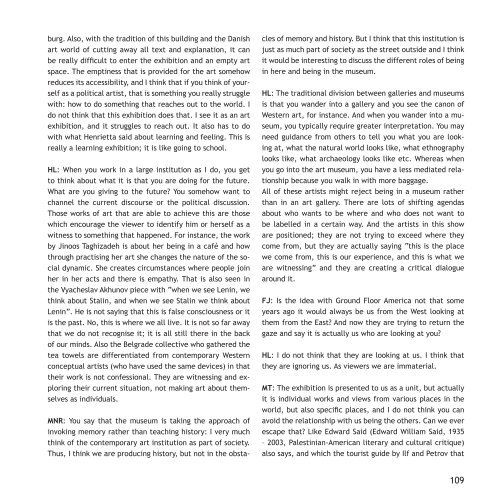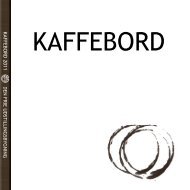læs bogen her - Den Frie
læs bogen her - Den Frie
læs bogen her - Den Frie
You also want an ePaper? Increase the reach of your titles
YUMPU automatically turns print PDFs into web optimized ePapers that Google loves.
urg. Also, with the tradition of this building and the Danish<br />
art world of cutting away all text and explanation, it can<br />
be really difficult to enter the exhibition and an empty art<br />
space. The emptiness that is provided for the art somehow<br />
reduces its accessibility, and I think that if you think of yourself<br />
as a political artist, that is something you really struggle<br />
with: how to do something that reaches out to the world. I<br />
do not think that this exhibition does that. I see it as an art<br />
exhibition, and it struggles to reach out. It also has to do<br />
with what Henrietta said about learning and feeling. This is<br />
really a learning exhibition; it is like going to school.<br />
HL: When you work in a large institution as I do, you get<br />
to think about what it is that you are doing for the future.<br />
What are you giving to the future? You somehow want to<br />
channel the current discourse or the political discussion.<br />
Those works of art that are able to achieve this are those<br />
which encourage the viewer to identify him or <strong>her</strong>self as a<br />
witness to something that happened. For instance, the work<br />
by Jinoos Taghizadeh is about <strong>her</strong> being in a café and how<br />
through practising <strong>her</strong> art she changes the nature of the social<br />
dynamic. She creates circumstances w<strong>her</strong>e people join<br />
<strong>her</strong> in <strong>her</strong> acts and t<strong>her</strong>e is empathy. That is also seen in<br />
the Vyacheslav Akhunov piece with “when we see Lenin, we<br />
think about Stalin, and when we see Stalin we think about<br />
Lenin”. He is not saying that this is false consciousness or it<br />
is the past. No, this is w<strong>her</strong>e we all live. It is not so far away<br />
that we do not recognise it; it is all still t<strong>her</strong>e in the back<br />
of our minds. Also the Belgrade collective who gat<strong>her</strong>ed the<br />
tea towels are differentiated from contemporary Western<br />
conceptual artists (who have used the same devices) in that<br />
their work is not confessional. They are witnessing and exploring<br />
their current situation, not making art about themselves<br />
as individuals.<br />
MNR: You say that the museum is taking the approach of<br />
invoking memory rat<strong>her</strong> than teaching history: I very much<br />
think of the contemporary art institution as part of society.<br />
Thus, I think we are producing history, but not in the obsta-<br />
cles of memory and history. But I think that this institution is<br />
just as much part of society as the street outside and I think<br />
it would be interesting to discuss the different roles of being<br />
in <strong>her</strong>e and being in the museum.<br />
HL: The traditional division between galleries and museums<br />
is that you wander into a gallery and you see the canon of<br />
Western art, for instance. And when you wander into a museum,<br />
you typically require greater interpretation. You may<br />
need guidance from ot<strong>her</strong>s to tell you what you are looking<br />
at, what the natural world looks like, what ethnography<br />
looks like, what archaeology looks like etc. W<strong>her</strong>eas when<br />
you go into the art museum, you have a less mediated relationship<br />
because you walk in with more baggage.<br />
All of these artists might reject being in a museum rat<strong>her</strong><br />
than in an art gallery. T<strong>her</strong>e are lots of shifting agendas<br />
about who wants to be w<strong>her</strong>e and who does not want to<br />
be labelled in a certain way. And the artists in this show<br />
are positioned; they are not trying to exceed w<strong>her</strong>e they<br />
come from, but they are actually saying “this is the place<br />
we come from, this is our experience, and this is what we<br />
are witnessing” and they are creating a critical dialogue<br />
around it.<br />
FJ: Is the idea with Ground Floor America not that some<br />
years ago it would always be us from the West looking at<br />
them from the East? And now they are trying to return the<br />
gaze and say it is actually us who are looking at you?<br />
HL: I do not think that they are looking at us. I think that<br />
they are ignoring us. As viewers we are immaterial.<br />
MT: The exhibition is presented to us as a unit, but actually<br />
it is individual works and views from various places in the<br />
world, but also specific places, and I do not think you can<br />
avoid the relationship with us being the ot<strong>her</strong>s. Can we ever<br />
escape that? Like Edward Said (Edward William Said, 1935<br />
– 2003, Palestinian-American literary and cultural critique)<br />
also says, and which the tourist guide by Ilf and Petrov that<br />
109



